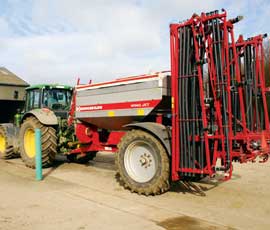Weighbridge proves a good management tool

How did Oakley perform this year in comparison with its average? Has the grain merchant correctly recorded every consignment of grain? What’s the yield trend in Top Field? How much is that truckload of straw worth?
Answers to these and many other questions are at Alan Covey’s fingertips, thanks to the installation of a discreet steel pad set flush with the concrete yard outside the grain store at Streetly Hall Farm near West Wickham, south-east of Cambridge.
“It’s the most cost-effective bit of kit I’ve ever bought,” he says. “We weigh everything – from grain coming in off the field to consignments of grain, oilseeds, beans and straw going off the farm.
“It provides information that can influence our variety and sowing decisions immediately after harvest, it tells us exactly how much grain of each variety we have to sell, and it accurately records the amount of grain we ship with every consignment,” he adds. “I couldn’t imagine farming without a weighing system.”
 Growing winter feed and milling wheat is the core business for Mr Covey’s (pictured) Streetly Hall Estate, which comprises three holdings of between 275ha and 356ha (680 and 880 acres) in the locality, plus a 400ha (1,000 acre) unit 12 miles away on the Cambridgeshire/Essex border.
Growing winter feed and milling wheat is the core business for Mr Covey’s (pictured) Streetly Hall Estate, which comprises three holdings of between 275ha and 356ha (680 and 880 acres) in the locality, plus a 400ha (1,000 acre) unit 12 miles away on the Cambridgeshire/Essex border.
Complete units
For both practical and strategic reasons, each has its own grain storage facility, including a weighbridge. “I decided that each farm should have its own store for easy harvest logistics and to minimise the amount of harvest road traffic in an area where the police are pretty hot on farm vehicles,” Mr Covey explains. “As complete units, it also makes them more attractive should we decide to sell, and more appealing to a member of the family who wants to manage a farm in their own right.”
Excluding the Essex unit, which is run as an individual enterprise by Mr Covey’s eldest son, Streetly Hall Estate typically sells more than 4,200t of wheat, 750t of oilseed rape, 330t of winter barley and 170t of winter beans off its 970ha. Feed varieties account for more than 80% of the wheat crop, with yields overall hovering around a 10t/ha (4t/acre) average.
The 3,000t capacity undercover bin store at Streetly Hall was built with crop marketing in mind after Alan Covey bought the farm in the late 1980s and completely re-worked the buildings layout to meet the efficiency – and security – needs of a modern, high-output arable enterprise.
The other two farms have 1,500-1,600t of storage, plus 500t bulk overflow capacity. Selling options are optimised by storing grain in the 60-160t bins by variety and field so that lots meeting particular specifications can be located easily.
“We have enough storage to hold 100% of our output, so I can hold off selling if we think the market is going to improve,” says Mr Covey. “And if a merchant wants a consignment of grain to a particular specification – for protein, for example – we can direct him to sample the bins most likely to provide it based on variety and harvesting date.”
All grain and other crops come off the combine in 18t trailers and pass over the weighbridge on their way to the store. With a discrepancy of no more than plus or minus 0.5%, weighing in bulk provides an accurate account of harvest.
Before the recording process begins, manager Paul Norman issues harvest staff with a field name map and familiarises them with the operating procedure for the Griffith ElderMulti Axle weighbridge. Weights are recorded on the firm’s standard Ton-Tel software, which runs on a laptop computer that can be plugged in at any of the farm stores.
“The software is populated with the tare weights of different tractor and trailer combinations and all the trailers are numbered,” Mr Norman points out. “The length of the platform means we weigh in two stages – tractor first, then trailer – with traffic lights showing when to move forward.”
The two figures are added together automatically, so all the driver has to do in the weighbridge office is create a ticket for each load using drop-down menus to select the appropriate field name and tractor/trailer combination. The Ton-Tel software then calculates the gross, tare and net weights before the record is saved.
It all takes no more than a couple of minutes and certainly has no significant impact on trailer turnaround time, says Mr Norman.
“I print out a strip of load tickets and every three or four days enter the moisture-adjusted weights into the field records in Farmplan GateKeeper,” he adds. “There’s probably a way of importing the data by memory stick but it only takes 10 to 15 minutes keying in total weights from around 10 fields at a time.
“Besides, doing the job manually means there’s more chance of spotting errors – such as the wrong field name being selected or loads being entered twice,” he adds.
About the weighbridge
The Griffith Elder Multi Axle weighbridge is a flush-fitting installation with platform lengths of 4m and 6m, both 3m wide. Prices of £6,560 and £7,700, respectively, include a desk indicator and printer, traffic lights and a pit frame.
An external display can be added, along with computer software providing different levels of additional recording and reporting, priced from £1,500 to £4,000 or thereabouts.
The Ton-Tel Split-Weigh system weighs one or two axle sets at a time, then adds them together to produce a total vehicle weight. The pit frame provides a guide for excavations and mountings for the weigh cells to ensure the weighbridge is located correctly. No on-site setting up is required because the system is factory calibrated.
Full-length weighbridges to trade-legal specification are also available, together with Ton-Tel Grain Storage software, which provides a more comprehensive bespoke database designed to generate the records needed by farmers who clean, store or dry combinable crops for other growers.
It provides detailed records of crop movements in and out, store location and details such as moisture content, admixture percentage, specific weight, temperature, and so on. It can also handle the calculations needed for invoicing and account analysis, and produce a selection of data reports.
Running progress report
Printing out the field record spreadsheet gives Mr Covey a running progress report, showing the performance of crops as they come in. By the end of harvest, he has a complete account of how each variety has performed field-by-field, as well as its overall average.
“That’s an invaluable resource for reviewing variety plans,” he says. “In some instances it has prompted us to make changes that we’ve been able to negotiate with our seed suppliers in time for drilling.”
Grain, oilseeds, pulses and straw heading off the farm are also weighed. It helps hauliers optimise payloads without the fiddle of having to make an adjustment if too much grain is put on board.
But more importantly for Mr Covey, it provides a record of every consignment and ensures hauliers do not collect more than an agreed quantity in their desire to take a full load.
“If you’ve contracted to sell 250t, the haulier collects 270t in full truckloads and the price goes up, you lose out on 20t,” he points out. “There’s also a risk of loads being missed at the intake; we’ve had a couple of instances of loads going missing, quite accidentally, I’m sure. But because we’ve had evidence of shipments off the farm, it’s been easy to sort out.”
In case of quality analysis disputes, a sample is retained from each consignment, together with a triplicate record of the dispatch that notes the weight, truck registration and driver’s signature. Likewise, each shipment of barley straw heading for the west country is weighed and paid for by cheque before it leaves the farm.
Occasional bulk purchases, like planings brought in to renew farm tracks, are checked in over the weighbridge to ensure there are no discrepancies. That used to be the case with bulk fertiliser as well, but with purchases made from a reputable source where weights are checked before dispatch, there is no longer any need.
Still, as Mr Covey points out, when suppliers know the farm has a weighbridge they tend to make sure all deliveries are correct.
A further role for the device emerges when fertiliser spreading is on the schedule; every load in the farming operation’s high-capacity trailed spreader is weighed on its way out of the yard to provide a useful double-check of the amount of fertiliser going on to the land.
“There’s no doubt in my mind about the value of having a weighbridge and the information it provides,” Mr Covey concludes. “I had no hesitation installing them at all four of our farms and in every case they’ve paid for themselves in the first year.”
Streetly Hall manager Paul Norman says creating the job tickets for each weighing is quick and easy; at harvest, he transfers field totals to Farmplan GateKeeper manually every two or three days to provide a picture of how varieties have performed.
The Ton-Tel Split Weigh system minimises the size of platform needed while providing accurate weights. Recording outgoing quantities of bulk fertiliser involves weighing the tractor first and then the spreader.
Other weighbridge makers

